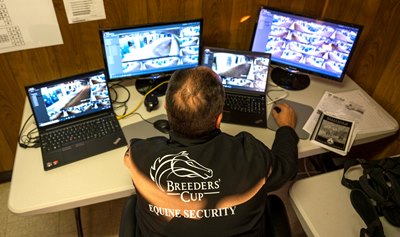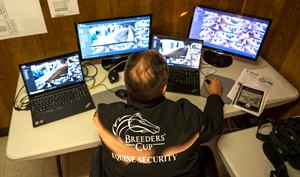Breeders' Cup Enhances Safety Protocols for 2020 Event


One year after a high-profile breakdown in the Breeders' Cup's biggest race, officials are redoubling oversight and adding to efforts to protect the equine participants.
"The Breeders' Cup continues to implement the most stringent equine health and safety protocols in the sport," Breeders' Cup president Drew Fleming said during a safety news conference Nov. 4.
The news conference, which included officials from Breeders' Cup, Keeneland, and the Kentucky Horse Racing Commission, covered a wide range of efforts relating to the safety of horses and humans at this year's event, including preventing the spread of COVID-19.
While the news conference didn't specifically mention the fatal breakdown of Mongolian Groom in last year's Longines Breeders' Cup Classic (G1), some highlighted protocols related to recommendations in a Breeders' Cup-commissioned report on last year's fatality by renowned equine surgeon Dr. Larry Bramlage reviewing.
Mongolian Groom had small stress fractures deep in both hind cannon bones when he started in last year's race, according to Bramlage's report, which reviewed veterinary and training records, the necropsy report, the horse's medication history, and videos of the horse's training. The horse had preexisting bilateral lameness that was difficult to detect.
It was the lone fatality from 229 horses who competed in the event's 14 races at Santa Anita Park.
Bramlage's recommendations included standardizing identification of horses before arrival who have prior concerns and concentrating the responsibility for individual horse examinations.
Mongolian Groom was seen by seven regulatory veterinarians—not including the attending veterinarian—who looked at the horse a total of 10 times. Bramlage said concentrating the group might have allowed "a more focused assessment."
Dr. Bruce Howard, the equine medical director for the KHRC, said in an interview Tuesday that a team of veterinarians continues to look at the horses "just to get more eyes," but that at least one veterinarian will be a constant in those reviews for any given horse.
"We're kind of combining what we had done before, along with (Bramlage's) recommendation," Howard said.
About 14 veterinarians, either with the KHRC or Breeders' Cup, are working the event as part of the Breeders' Cup team, said veterinary team co-leader Dr. Will Farmer, who is Churchill Downs Inc.'s equine safety director and the former chief vet for the KHRC.
One suggestion being used from Bramlage to improve on-track observation of participants designates an extended track section that Breeders' Cup horses trot through under tack in front of veterinarians on training days.
That under-tack examination is being done in the backstretch chutes at Keeneland and Churchill Downs for Breeders' Cup entrants.

"That's been working out very well," said Dr. Deborah Lamparter, co-leader of the Breeders' Cup veterinary team. "The horsemen have been very cooperative."
As suggested by Bramlage, vets for the event are reviewing more video, including from non-regulatory sources. Any horses identified on track or through video as "horses of concern" have additional reviews and jogs at their barns.
Bramlage's report also suggested making diagnostic imaging—such as radiographs, nuclear scans, ultrasounds, MRI, and PET scans—an accepted part of the pre-race exams for selected horses. They weren't done with Mongolian Groom because no need was observed.
Howard said diagnostics are being requested as needed.
"We've had a few, and people are being very compliant with us," Howard said. "They understand what we're trying to accomplish here. Everything is for the safety of the horse."

Howard said an additional aid in the safety effort this year comes from Kentucky rules that took effect this year and pushed back the times when certain medications could be administered. Corticosteroids can't be given inside of 14 days of a race where Kentucky previously allowed them up to seven days before a race, Howard said. Nonsteroidal anti-inflammatories can't be given inside of 48 hours, instead of 24.
The stricter guideline "gives us a much better chance to examine these horses in a true state," Howard said.
